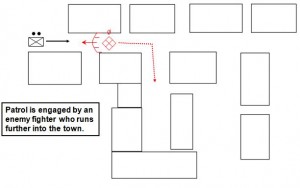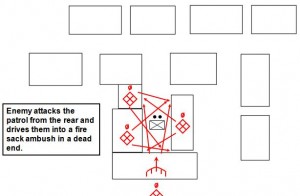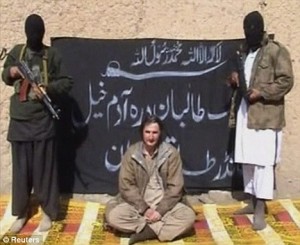Andrew Exum blogging at Abu Muqawama has a piece up on who he perceives to be the winner and losers in Tom Ricks’ new book The Gamble: General David Petraeus and the American Military Adventure in Iraq, 2006-2008. I personally like Andrew and have enjoyed the exchanges I have had with him, via e-mail and in blog articles. But let’s deal with a few items from this post by Andrew.
First, one of the “losers” is determined to be Colonel Gian Gentile who commanded a Battalion in Baghdad in 2006. Tom Ricks judges the performance of his unit to be “actually quite poor.” Major General Hammond is cited saying “Gentile had a different stance. It was night and day. He was FOB-centric. We are JSS-centric.”
Well, do tell. Actually, I judge the performance of books that promulgate myths to be poor. I have not read the book because Tom hasn’t sent me a free copy to review. Had he sent me a copy I would have responded. As a matter of fact, I haven’t even been able to get Tom to respond to a single e-mail. But if Tom’s book advocates the idea that the campaign was won by jettisoning the notion of FOB-centric counterinsurgency and embracing Combat Outposts (or Joint Security Stations), then it is an exercise in simplistic myth-telling.
We have dealt with this before, this notion of a simple, one line narrative for Iraq. The country, the security situation, the units, the commanders, and the enemy was simply too diverse for a one-size-fits-all narrative. Even as late as the middle of 2007 operations were conducted in Fallujah, Anbar that were essentially FOB-centric. The Marines in Operation Alljah would spend some time at JSS, but rotate in and out of them, never spending more than about two or three weeks per rotation. The FOB was the main strategy for force protection, and yet the Marines still spent most of their time interacting with the population no matter where they garrisoned (heavy census operations, heavy patrolling, and especially heavy kinetic operations). These operations were so successful that many high level visitors were received to discuss the methods, including the Commandant of the Marine Corps.
To say that a commander is FOB-centric is to say nothing more than he is committed to force protection. It means nothing regarding the ability to do counterinsurgency. And so now we have let the cat out of the bag, haven’t we? There it is. The great myth. Now, let’s distinguish between levels. Currently much of the Army in Afghanistan is cloistered into huge FOBs and left without much contact with the population. Let’s contrast that the right way to do it. In Opening a Combat Outpost for Business, we listened as the Marines built their force protection.
Marines with 2nd Platoon, Motor Transportation Company, Combat Logistics Battalion 3, conducted multiple combat logistics patrols in support of Operation Gateway III in Farah Province, Islamic Republic of Afghanistan Dec. 28, 2008, through Jan. 25, 2009.
The logistics combat element Marines, part of Special Purpose Marine Air Ground Task Force – Afghanistan, endured more than two weeks behind their steering wheels and gun turrets in improvised explosive device-laden terrain during the initial phases of the operation. Military planners with SPMAGTF-A designed Operation Gateway III as a deliberate plan to clear southern Afghanistan’s Route 515 of any existing IED and insurgent threats on the important east-west route.
The combat logisticians directly supported 3rd Battalion, 8th Marine Regiment (Reinforced), the ground combat element of SPMAGTF-A, with the essential supplies and construction support necessary to erect three combat outposts at strategic locations along Route 515. In a limited amount of time, the three locations were successfully developed from barren land into safe havens for the 3/8 Marines occupying the area.
“Ultimately I was surprised,” said Staff Sgt. Chris O. Ross, platoon sergeant. “The COPs were built quickly, and the Marines were working overtime to do it.”
Ross also said the timing and coordination required to conduct the operation came together well.
Second Lt. Juliann C. Naughton, 2nd Platoon’s convoy commander, explained it’s shocking for the locals to wake up the next morning to see that a military outpost has appeared from nowhere during the course of the night.
“The logistical support was a success, and we delivered the materials in a timely manner,” Naughton said. “We’ve also been interacting with the villagers and letting them know why we’re here.”
Fortifications including concertina wire, a parapet several feet tall and dirt-filled protective barriers ensured the Marines on the interior of the COPs were shielded from outside threats. Multiple observation posts and several heavy and medium machine guns provided security and over-watch for the combat logisticians as they performed their craft.
The interior of the COPs offer living quarters, hygiene facilities, combat operations centers and more to accommodate its current and future residents.
The posts were strategically placed along the route to show an alliance presence, as well as enable safe travel.
And thus can it be done successfully, this notion of force protection combined with contact with the population. To set them in juxtaposition as opposites or somehow mutually exclusive is the grand myth around which the narrative of the surge is being built. In reality, the situation was more complicated, a subject we covered in The Surge.
Second, Gian Gentile asks Tom in the comments of this post at Abu Muqawama:
Ref your book Fiasco, which at the end you spend about a page talking about my unit, 8-10 Cav. In Fiasco you said this about my unit and what we were doing in 2006:
“… overall the US effort was characterized by a more careful, purposeful style.”
you even went on to praise a simple tactic of slow mounted movement that we adopted and noted that
“it was less disruptive to the Iraqis and sends a message of calm, control…”
OK, you were not saying that Gentile was the next Galula, that they were on the way to winning the war by themselves. But clearly your impression was positive, at least the way you portrayed us in Fiasco.
Then The Gamble comes along and in it you become a harsh critic of my unit’s performance (and that criticism was based on the same embed tour that you did with us in early February). So what changed between the two books?
To which Tom responds thusly:
‘what changed between the two books?’
A small civil war, and the prospect of defeat.
So there you have it. One may ask rhetorically what this has to do with Gian Gentile, and the obvious answer is nothing whatsoever. So we may conclude that Tom doesn’t have a good answer for what happened between the two books.
Third, as for Gian, he and I have slightly disagreed and nuanced our arguments to come to agreement elsewhere, such as with Sadr (I believe that marginalization of his forces did him in, and that he wouldn’t have been alive anyway had the 3/2 Marines had their way, as he was under their custody in 2004) and the Sons of Iraq and pay to participate (which saw robust use in the Anbar province in 2007 as it should have).
But Gian is a great American and a warrior-scholar, and to place him in the category of “loser” as Andrew does is simply bad form. There is no excuse for it. Again, I like Andrew, but he seems to have bought into the Gnostic version of counterinsurgency. Only a few “get it,” and the rest of us should simply be consigned to the doofus category in counterinsurgency. Such may be the indiscretions of youth.
Andrew is a bright young man and his contributions to this discipline in the future will be enormous. But with this authority comes responsibility. Andrew should be circumspect with his thoughts. Gian doesn’t advocate jettisoning counterinsurgency doctrine, any more than he wishes to lose the campaigns in which we are engaged. Gian wants to be prepared for the future, no matter what that may bring. It was a very wise man who once said:
“For waging war you need guidance, and for victory many advisers” (Proverbs 24:6, NIV).
See also: The Man in the Arena, Small Wars Journal Blog






